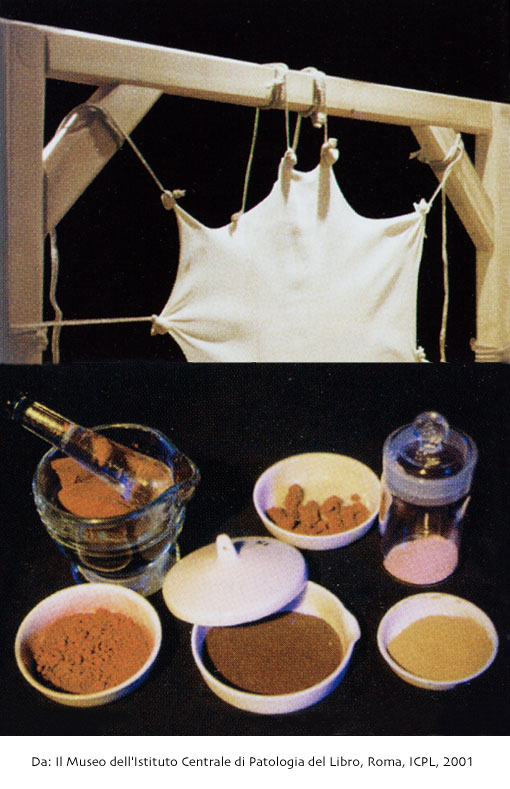THE MATERIALS

Early book covers were executed using wood, leather, parchment, and embellished with metal ornaments in medieval times.
The use of wood for the boards was characteristic of medieval bookbinding. Local wood was the most favoured material for making boards. Starting from the 14th century, beech came into widespread use. Central and northern Europe, however, went on using oak. Medieval bindings featured clasps, corner plates and bosses, generally made of bronze, brass or iron.
Rather than serving only as a writing surface for the codices, in the 15th century parchment was also used as a jacket for the boards. Tanned hide instead was utilized for the covers of codices, and for the component parts of a binding's structural framework: bands, endbands and ties.
Parchment was made out of sheepskin, goatskin or calfskin. The skin was immersed in a salt bath, stretched evenly on a frame and left to dry.
Leather was made from the skin of several animals. The hide was first unhaired, then tanned.
Medieval bookbinding employed leather exclusively for the spine, the bands, the endbands in some cases, and also as a partial or an all-over jacket for the boards.
The use of tawed leather was characteristic of the early Middle Ages: the skin was treated with aluminum salts and fat. The late Middle Ages instead utilized vegetable tanned leather. Tanning prevented natural decay, and made leather water-resistant and heatproof.
Listed below are the main types of leather used for wooden or cardboard boards:
Morocco: goatskin with a pinhead grain pattern. It is the best leather for bookbinding: soft, durable, vegetable tanned and dyed, easily processed. Elegant and strong, it emphasizes gold tooling. Morocco is very expensive leather, which is why it was used mostly for treasure bindings. De luxe 16th-century book covers were generally bound in red fine-grained morocco.
Sheepskin: leather from a sheep's skin left in the undyed state. It is smooth and soft, yet little durable and therefore easily scratched and cracked. Second-rate leather, it was reserved for bindings of lower quality.
Calfskin and cowhide: very delicate, smooth leather without any noticeable grain pattern. The finest version of this kind of leather is light brown, and even and regular throughout, smooth and free from grain defects.
Pigskin: the hide of a domestic pig. Ivory-coloured like parchment, it was used extensively as bookbinding leather in northern Europe from the 16th century to the end of the 18th. Tough and indestructible leather, it has the characteristic grain pattern formed by the hair follicles which are arranged in triangular groups of three. Naturally coloured white, it has a tendency to take on a golden patina. Easily obtained, pigskin was the most favoured bookbinding leather in Germany, not least because it was eminently suitable for blind tooling.

